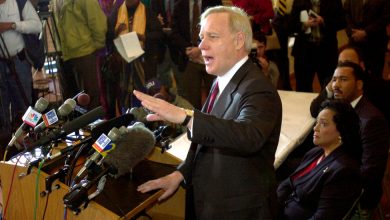‘Free Joe Biden’: Sean Maloney on How Democrats Can Get Back on Track

In the days since Democrats were battered in elections across the country last week, criticism of the party’s policies and electoral strategies has rained down, alongside dire forecasts of its prospects in the 2022 midterms. The flagellation has come not just from gleeful Republicans, but from many in the Democratic ranks.
Reasons put forward for the party’s losses included President Biden’s slipping approval in polls, impressions of a party that is incompetent at governing after months of infighting in Congress, rising inflation and crime in big cities, and tin-eared Democratic campaigns.
One of the least envied jobs in politics at the moment belongs to Representative Sean Patrick Maloney of New York, who as chair of the Democratic Congressional Campaign Committee must steer his caucus through the extremely choppy midterm waters. Mr. Biden’s approval numbers are lower than President Barack Obama’s were at the same point in his first term, ahead of the 2010 midterms when Democrats lost more than 60 House seats.
In an interview with The New York Times on Monday, Mr. Maloney acknowledged the party’s challenges, but he rejected the idea that any major stocktaking was needed in terms of the Democratic agenda or the party’s focus on running against former President Donald J. Trump even without him on the ballot in 2022.
Mr. Maloney maintained that the ground was already shifting in Democrats’ favor after the House’s Friday passage of the $1 trillion infrastructure bill, which is headed for the president’s desk.
Mr. Maloney’s big takeaway from the electoral thumping was that Democrats need to do a better job getting the message out about their achievements — and that starts at the very top, with Mr. Biden. The interview has been lightly edited and condensed.
There are about 50 Democratic-held House seats in congressional districts that President Biden won by less than he carried Virginia. Now that a Republican, Glenn Youngkin, has won the Virginia governor’s race, is it time for Democrats to make a radical readjustment to save themselves next year?
The results in Virginia and elsewhere ought to be a wake-up call that we’re not getting the job done on messaging. It starts with the president.
The No. 1 thing is to grow the economy and end the pandemic. But close behind that is telling people what you’ve done. I think it’s a fair criticism to say we haven’t done enough of that, and I think the White House needs to do more. I don’t think the president has been served well in this regard. It needs to happen right away.
The president needs to get himself out there all around the country and do events in local media markets to punch through these key messages. I think the White House should do 25 presidential events in the next couple months just on infrastructure. And we should do 1,000 congressional events alongside those presidential events.
My message is “free Joe Biden.” That campaign needs to start now before the next crisis takes over the news cycle.
Since Terry McAuliffe’s loss in Virginia, Democratic strategists have said his efforts to tie Youngkin to Trump — virtually his No. 1 campaign issue — didn’t work. You’ve been advising House members in vulnerable seats to run against “Trump toxicity without Trump on the ballot.” Didn’t we just see why that won’t be a winning playbook for Democrats in the midterms?
Let’s unpack that. Glenn Youngkin ran like a teenaged girl in a slasher movie away from Donald Trump. They’re making fun of him on “Saturday Night Live” for how much he tried to run away from Donald Trump.
The competitive congressional districts are in largely suburban swing areas, and in those areas, Glenn Youngkin underperformed Mitt Romney. I think it’s more complicated than people are saying. Trump’s toxicity continues to be a tremendous liability with suburban swing voters.
Democrats took the majority in the House in 2018 and the White House in 2020 because of suburban voters. But it would appear that after last week, when Republicans made inroads in suburbs in Virginia, New Jersey and on Long Island, N.Y., that you were only “renting” those voters.
Youngkin did better in the suburbs than Trump did, that’s true. But Kevin McCarthy [the Republican House minority leader] is no Glenn Youngkin. He’s got 12 of his top recruits spreading the big lie about the election being stolen.
I think what you’re seeing is that there’s real damage to the Republican brand in suburban areas and even Glenn Youngkin couldn’t overcome it. When he was able to add to his totals a strong turnout among the Trump base in rural counties, he was able to beat McAuliffe, but only by two percentage points.
The Infrastructure Bill at a Glance
The bill receives final approval. The House passed a $1 trillion bill on Nov. 5 to rebuild the country’s aging public works system. The proposal is a central plank of President Biden’s economic agenda, and he is expected to quickly sign it into law. Here what’s inside the bill:
Transportation. The proposal would see tens of billions of dollars in new federal spending going to roads, bridges and transportation programs. Amtrak would see its biggest infusion of money since its inception, and funds would be allocated to programs intended to provide safe commutes for pedestrians.
Climate. Funding would be provided to better prepare the country to face global warming. The Forest Service would get billions of dollars to reduce the effects of wildfires. The bill includes $73 billion to modernize the nation’s electricity grid to allow it to carry renewable energy.
Resources for underserved communities. A new $2 billion grant program is expected to expand transportation projects in rural areas. The bill would also increase support for Native American communities, allotting $216 million to the Bureau of Indian Affairs for climate-resilience and adaptation efforts.
Internet access. The bill includes $65 billion meant to connect hard-to-reach rural communities and low-income city dwellers to high-speed internet. Other provisions seek to stoke competition and transparency among service providers.
In a competitive congressional district, I think it’s still very true that the violent attack on the Capitol, spreading conspiracy theories about the pandemic and denying the results of the election are lousy politics.
Youngkin’s most effective message was that parents have been shut out of influencing how schools are run — including everything from school closures to mask mandates to how America’s racial history is taught. The G.O.P. believes “parents’ rights” is a winning message in 2022. Is it enough for Democrats to do what McAuliffe did, which was to simply say that the critical race theory attacks were a dog whistle for racist voters?
Every House Republican voted against the most important funding for our public schools in decades, which we passed in the $1.9 trillion coronavirus rescue plan in March.
Democrats are the party of education. If we engage on that subject, we’ll win that debate with Republicans, who are all talk and no action. We will take seriously and respond aggressively to the lies and distortions that Republicans substitute for having good ideas on education, starting with critical race theory.
Representative Abigail Spanberger of Virginia, one of the most endangered Democrats next year, told The Times last week that Biden was elected to put an end to Trump’s chaos, not to enact sweeping policy changes. “Nobody elected him to be F.D.R.,” she said.
We just passed the most important infrastructure bill in our country’s history and it will be wildly popular with voters. I think those comments are already out of date. What is wrong with F.D.R. if you get the achievements?
James Carville, the longtime political strategist, blamed what he called Democrats’ “stupid wokeness” for the losses last week. In deep-blue Minneapolis, voters defeated a measure to replace the Police Department with a public safety department in a year of rising crime, and in deep-blue Seattle, a Republican won the city attorney race against a Democrat who called herself a police abolitionist. Does Carville have a point?
It sounds like he’s buying into the false choice between fighting for racial justice and public safety. We can do both. Or he’s buying into a false choice between guaranteeing equal rights for all our citizens or success at the polls.
What bothers me about James Carville’s remarks is that he’s glib about the fight for racial equality or full equality for all our citizens. I understand what James is trying to say, but I think it’s just a false equation. But he did win some elections back in the ’90s.



